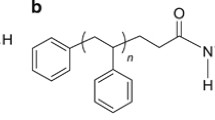Abstract:
Heterotelechelic deuteropolystyrenes have been synthesised with a tertiary amine functionality at one end and a fluorocarbon group at the other end of the polymer chain. A layer of this polymer, circa 120 Å thick, has been attached to the surface of a silicon substrate and subsequently covered with a much thicker layer of hydrogenous polystyrene. The combination has then been annealed at 413 K under vacuum for defined times and the subsequent distribution of the deutero heterotelechelic polymer determined using nuclear reaction analysis and neutron reflectometry. The influences of annealing time, molecular weight and thickness of the hydrogenous polymer have been examined. Nuclear reaction analysis showed that an excess of the heterotelechelic polymer formed at both interfaces with a larger excess remaining at the substrate-polymer interface. When the molecular weight of the hydrogenous polymer is lower than that of the deuteropolymer, the deutero layer is initially swollen by the hydrogenous polymer but the thickness then decreases as deutero polymer becomes detached from the silicon substrate and an additional excess layer is eventually formed at the vacuum-polymer surface. When the molecular weight of the hydrogenous polymer is higher, there is an initial shrinkage of the deuteropolymer layer, but the original thickness (∼ radius of gyration of the deuteropolymer) is regained on prolonged annealing. There is no evidence for bridging between the two interfaces by the heterotelechelic polymer. After five days annealing the volume fraction distribution of the deuteropolymer at the silicon substrate was well described by a self-consistent field model where the only adjustable parameter was the sticking energy of the tertiary amine group to the silicon substrate for which a value of 8k B T was obtained. Comparison of the dependence of the equilibrium layer thickness of the deuteropolymer on the equilibrium grafting density at the silicon surface with the predictions of scaling theory for brush-like polymer layers suggested that the grafted molecules were in the ideal, unperturbed brush region.
Similar content being viewed by others
Author information
Authors and Affiliations
Additional information
Received 12 October 2000 and Received in final form 27 March 2001
Rights and permissions
About this article
Cite this article
Hutchings, L., Richards, R., Thompson, R. et al. Partitioning of a heterotelechelic polystyrene to separate interfaces of thin films. Eur. Phys. J. E 5, 451–464 (2001). https://doi.org/10.1007/s101890170052
Issue Date:
DOI: https://doi.org/10.1007/s101890170052



